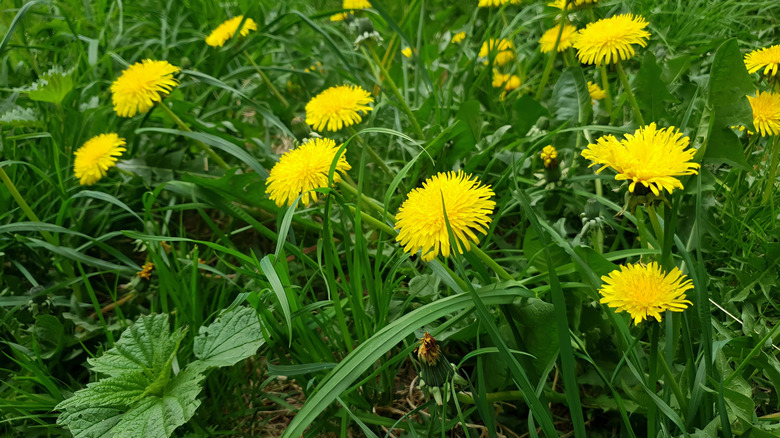The Proven Strategy That Stops Dandelions From Invading Your Lawn
Dandelions often seem to be the most resilient and determined weeds in the yard. An ounce of prevention is definitely worth a pound of cure when fighting them. Growing a healthy lawn that can resist the weedy invaders is the smartest strategy to prevent a dandelion takeover. And overseeding can be one of the best ways to grow a healthy lawn resistant to dandelions.
Sometimes it seems that no matter how often we fertilize our lawns or mow, the bright yellow flowers and their furry seed poms seem unstoppable, and if left unchecked, can overtake almost any lawn. Among the dandelion flower facts is that they're relentless growers who can thrive in almost all conditions. For example, they are a hardy perennial with resilient, deep roots that can regrow an entirely new plant even from just a single inch of root left beneath the surface. Dandelions can thrive in wet or dry conditions, and that's a big reason why once they're established, they can be difficult to get rid of.
Making sure your grass is as healthy as possible helps the grass roots grow densely without giving dandelions a chance to move in and make themselves at home. The first steps to a healthy lawn is to make sure it's got thick growth and no bald patches — those are an open invitation to dandelions and other weeds. Give your lawn a boost with overseeding. A lawn mower, a core aerator, rake, and seed spreader are the tools needed to plant grass seed.
The best defense against dandelions is a good offense
Before you get to work overseeding your lawn, let's talk the best time to overseed. The answer depends on where you live. In colder climates, the spring or fall can be the best time to overseed. In warmer, southern climates, late spring and early summer might be best. You can overseed every year, especially if you notice patchy areas in the yard, but once grass is thick and healthy, you can skip a year or two.
Once you've decided the right time, you're ready to go. Set your mower at 2 to 2 ½ inches. If you're not sure how to set the height on a lawn mower, then check out your owner's manual. Mow your lawn, bag the clippings, and then rake to get rid of any leaves or twigs so you give seeds the best chance to cozy up to the soil. Now it's time to aerate. Then, separate your seeds into two parts. Spread half vertically, and the other half horizontally across your lawn.
It's a good idea to water the seeds after planting. Watering is key to the seeds taking root, so don't seed if you can't water regularly. At this stage, a garden hose or sprinkler will be your lawn's new best friend. Using a turf-builder or starter fertilizer can be a good idea as well. Just avoid potassium in your fertilizer, as this has been shown to feed dandelions and encourage them to grow.

